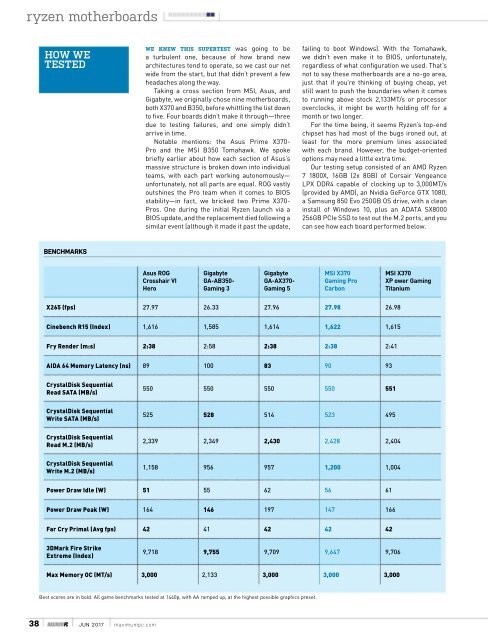Maximum_PC_June_2017
Create successful ePaper yourself
Turn your PDF publications into a flip-book with our unique Google optimized e-Paper software.
yzen motherboards<br />
how we<br />
tested<br />
we knew this supertest was going to be<br />
a turbulent one, because of how brand new<br />
architectures tend to operate, so we cast our net<br />
wide from the start, but that didn’t prevent a few<br />
headaches along the way.<br />
Taking a cross section from MSI, Asus, and<br />
Gigabyte, we originally chose nine motherboards,<br />
both X370 and B350, before whittling the list down<br />
to five. Four boards didn’t make it through—three<br />
due to testing failures, and one simply didn’t<br />
arrive in time.<br />
Notable mentions: the Asus Prime X370-<br />
Pro and the MSI B350 Tomahawk. We spoke<br />
briefly earlier about how each section of Asus’s<br />
massive structure is broken down into individual<br />
teams, with each part working autonomously—<br />
unfortunately, not all parts are equal. ROG vastly<br />
outshines the Pro team when it comes to BIOS<br />
stability—in fact, we bricked two Prime X370-<br />
Pros. One during the initial Ryzen launch via a<br />
BIOS update, and the replacement died following a<br />
similar event (although it made it past the update,<br />
failing to boot Windows). With the Tomahawk,<br />
we didn’t even make it to BIOS, unfortunately,<br />
regardless of what configuration we used. That’s<br />
not to say these motherboards are a no-go area,<br />
just that if you’re thinking of buying cheap, yet<br />
still want to push the boundaries when it comes<br />
to running above stock 2,133MT/s or processor<br />
overclocks, it might be worth holding off for a<br />
month or two longer.<br />
For the time being, it seems Ryzen’s top-end<br />
chipset has had most of the bugs ironed out, at<br />
least for the more premium lines associated<br />
with each brand. However, the budget-oriented<br />
options may need a little extra time.<br />
Our testing setup consisted of an AMD Ryzen<br />
7 1800X, 16GB (2x 8GB) of Corsair Vengeance<br />
LPX DDR4 capable of clocking up to 3,000MT/s<br />
(provided by AMD), an Nvidia GeForce GTX 1080,<br />
a Samsung 850 Evo 250GB OS drive, with a clean<br />
install of Windows 10, plus an ADATA SX8000<br />
256GB <strong>PC</strong>Ie SSD to test out the M.2 ports, and you<br />
can see how each board performed below.<br />
BENCHMARkS<br />
Asus ROG<br />
Crosshair VI<br />
Hero<br />
Gigabyte<br />
GA-AB350-<br />
Gaming 3<br />
Gigabyte<br />
GA-AX370-<br />
Gaming 5<br />
MSI X370<br />
Gaming Pro<br />
Carbon<br />
MSI X370<br />
XP ower Gaming<br />
Titanium<br />
X265 (fps) 27.97 26.33 27.96 27.98 26.98<br />
Cinebench r15 (Index) 1,616 1,585 1,614 1,622 1,615<br />
fry render (m:s) 2:38 2:58 2:38 2:38 2:41<br />
aIda 64 Memory latency (ns) 89 100 83 90 93<br />
Crystaldisk Sequential<br />
read Sata (MB/s)<br />
550 550 550 550 551<br />
Crystaldisk Sequential<br />
write Sata (MB/s)<br />
525 528 514 523 495<br />
Crystaldisk Sequential<br />
read M.2 (MB/s)<br />
2,339 2,349 2,430 2,428 2,404<br />
Crystaldisk Sequential<br />
write M.2 (MB/s)<br />
1,158 956 957 1,200 1,004<br />
Power draw Idle (w) 51 55 62 56 61<br />
Power draw Peak (w) 164 146 197 147 166<br />
far Cry Primal (avg fps) 42 41 42 42 42<br />
3dMark fire Strike<br />
extreme (Index)<br />
9,718 9,755 9,709 9,647 9,706<br />
Max Memory oC (Mt/s) 3,000 2,133 3,000 3,000 3,000<br />
Best scores are in bold. All game benchmarks tested at 1440p, with AA ramped up, at the highest possible graphics preset.<br />
38 MAXIMUM<strong>PC</strong> jun <strong>2017</strong> maximumpc.com


















